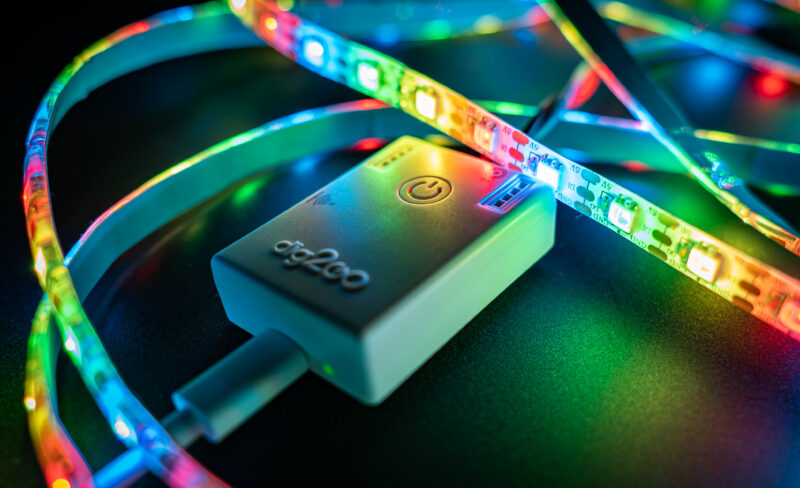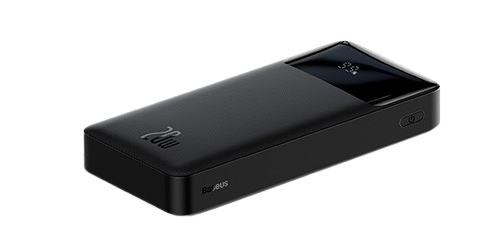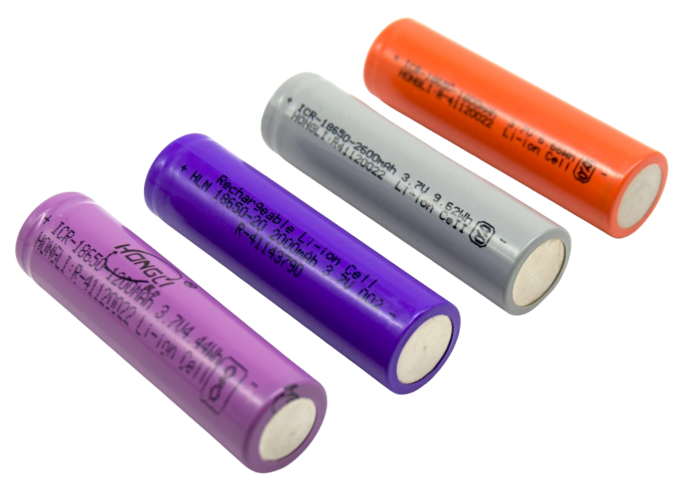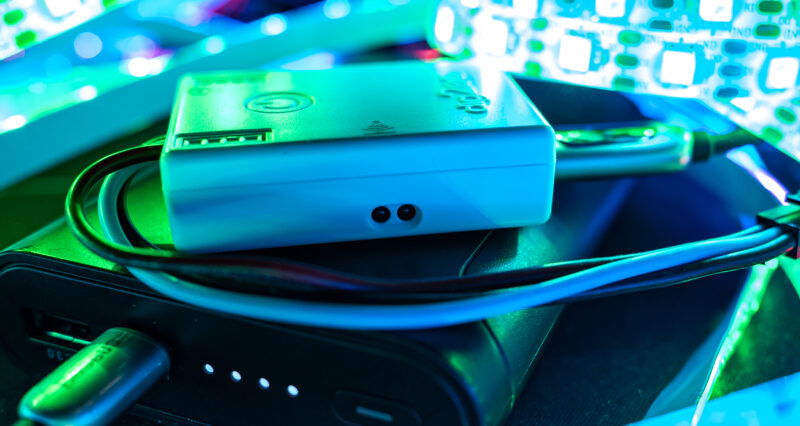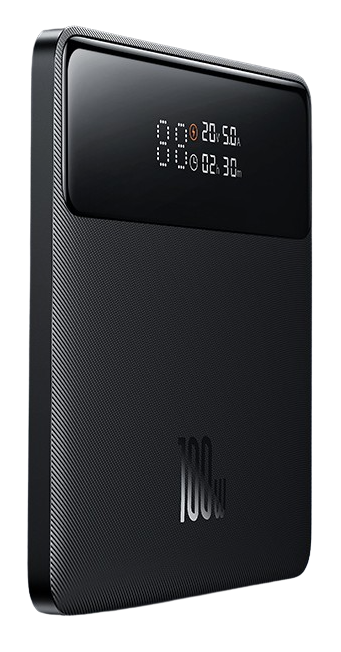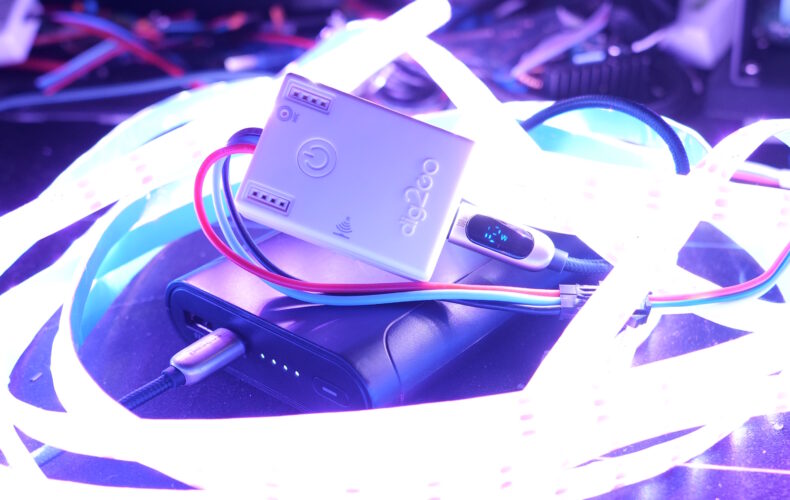Using a USB powerbank for addressable LEDs
In this article we’ll explore the usage of USB-(A or C) powerbanks to run addressable LEDs such as ws2812b or sk6812 LED strips or ws2811 based pixels. Since this is for USB powerbanks we’ll be mainly focusing on 5v and the dig2go controller.
5v is most efficient
Partly why we are focusing on 5v addressable LEDs is since they are most efficient. 12v LED strip can be as efficient if they are the “split over 3 LEDs” kind. Anything else such as ws2815 for instance or 12v ws2811 (bullet) pixels uses linear regulators to drop the voltage down backup to around 5v for the LED to use. This dropping is basically “burning off the voltage” and thus is converting the excess voltage not into light (like is done with the per 3 LED addressable strips) but into heat. This inherently makes these types of LED strip or pixels (much) less efficient then their 5v equivalent. So much so that a regulated 12v ws2811 pixel uses twice the amount of power to display the same amount of light vs a 5v version!
Running 12v LEDs can still make other things easier to do such as power injection but for battery powered projects I recommend picking an as efficient as possible LED and most often that’s a 5v variant!
The dig2go controller
The dig2go controller was introduced at the end of 2022 and it’s a ESP32 powered WLED addressable controller like the Dig-Uno and Dig-Quad. But it has some unique features such as having USB-C as it’s power input method, an integrated MOSFET “relay” circuit, level-shifter, built-in IR receiver, built-in high quality digital microphone (for audio reactive effects), custom injection molded plastic case while keeping female headers for expandable options!
This controller is able to source 5v 3A so 15w using it’s USB-C input and will correctly request this from a USB-A or USB-C port. If you weren’t planning to do power injection, this isn’t much below the maximum of about 4Amps you are able to get into an LED strip anyway so it makes for a very quick and easy, true plug & play solution to running 5v addressable LEDs.
*If you want to use a generic ESP32 board to do the same, please don’t exceed the default 850mA setting of the power limiter in WLED, for most ESP32 development boards this is already at the upper side of the amount of current they can carry, pushing more can be dangerous, get a properly designed controller for this purpose, those will have no problem handling the current (like the dig2go).
True capacity of a USB powerbanks
USB powerbanks are often marketed as being 10.000mAh or 20.000mAh, although these are true values, these values point towards the capacity of the lithium cells within the powerbank. The voltage of these lithium-ion batteries however is 3.7v and not 5v which USB is. This means the total amount of energy available at 5v isn’t the listed mAh of the powerbank! Personally I feel this is a little bit misleading, but that’s how it’s done. Luckily we can easily convert this!
Convert native Battery voltage to USB voltage
So let’s do 3 example calculations from the 3.7v nominal voltage of the cells to the 5v the USB ports needs. An important fact to remember is that converting voltages even using DC-DC conversion isn’t free, there is always going to be some losses. Generally those will only be a few precent but in our calculation examples we’ll use 10% as a worst case scenario. This is a guestimate though, cheaper powerbanks will have a worse conversion rate vs more expensive versions.
Converting the voltage
- 10.000mAh (37Wh)
- 10.000mAh @3.7v is 7.400mAh @5v
- 10% conversion loss for 7.400mAh is 740mAh
- Final true usable capacity is 6.660mAh or 6.6Ah
- 20.000mAh (74Wh)
- 20.000mAh @3.7v is 14.80000mAh @5v
- 10% conversion loss for 14.800mAh is 1.480mAh
- Final true usable capacity is 13.320mAh or 13.3Ah
- 25.600mAh (95Wh)
- 25.600mAh @3.7v is 18.944mAh @5v
- 10% conversion loss for 18.944mAh is 1894mAh
- Final true usable capacity is 17.050mAh or 17Ah
How long will my LEDs run?
How long your LEDs are actually going to run for off the powerbank will fully depend on the power usage of the selected pattern and brightness. The dig2go controller itself only uses about 0.1A or 0,5w so running just that on even the smallest (10.000mAh) powerbank means it will last for 66 hours or about 3 days!
But let’s say we use the WLED power limiter and set it to 1500mA in theory that means whatever pattern we select power usage shouldn’t exceed that value.
1.5Amps runtime
1.5Amps of 1500mA will give you a decent amount of light output but does sacrifice some of the light out potential for runtime!
- 10.000mAh (6.660mAh effective) can run 1500mA for 4,44 hours non-stop!
- 20.000mAh (13.320mAh effective) can run 1500mA for 8,88 hours non-stop!
- 25.600mAh (17.050mAh effective) can run 1500mA for 11,36 hours non-stop!
3Amps runtime
Let’s see what happens if we run full out and use all the power available!
- 10.000mAh (6.660mAh effective) can run 3000mA for 2,22 hours non-stop!
- 20.000mAh (13.320mAh effective) can run 3000mA for 4,44 hours non-stop!
- 25.600mAh (17.050mAh effective) can run 3000mA for 5,68 hours non-stop!
Powerbank recommendations
It’s recommended to get a modern power supply which has USB-C out and is rated to provide at least 15w of output current. Although most USB-A powerbanks will also work some people have reported issues that older powerbanks can’t deliver the initial startup current or shut off over time when drawing more then 1Amps for instance.
More modern powerbanks should not have these issues, especially when using a proper USB-C to USB-C connection!
Here are some (affiliate link) good examples which can handle the expected load:
![]() 5000mAh Direct Plug-in A powerbank that’s small in size but plugs right in directly to the bottom of the dig2go, very nice and compact setup!
5000mAh Direct Plug-in A powerbank that’s small in size but plugs right in directly to the bottom of the dig2go, very nice and compact setup!
![]() Baseus 20w A good quality powerbank available in 10.000mAh, 20.000mAh and 30.000mAh which is 15w output capable on USB-C (only!)
Baseus 20w A good quality powerbank available in 10.000mAh, 20.000mAh and 30.000mAh which is 15w output capable on USB-C (only!)
![]()
Kuulaa 20w A Good quality 20.000mAh powerbank with multiple outputs, capable of at least 15w output on all ports.
![]() Baseus 100w A very high quality 20.000mAh powerbank, capable of 100w output and 65w USB-C PD charging, will also charge your laptop!
Baseus 100w A very high quality 20.000mAh powerbank, capable of 100w output and 65w USB-C PD charging, will also charge your laptop!
![]() Movespeed 100w Also a very high quality powerbank, low price for 25.600mAh and easily able to provide power for 1 or 2 dig2go’s for a while!
Movespeed 100w Also a very high quality powerbank, low price for 25.600mAh and easily able to provide power for 1 or 2 dig2go’s for a while!
And lots of other powerbanks will be compatible too. It is however advised to check if the USB-A/C port can output up to 3A (so 5v 3A = 15w) to be able to reach the maximum potential possible of the dig2go. There have also been reports that some very old powerbanks can handle the transient currents of the LEDs very well and might sometimes shut down, newer (often USB-C PD compatible) powerbanks have shown no such issues.
High Quality USB cables
It’s advised to use a high-quality, preferably a USB-C to USB-C 5A rated cable, to minimize voltage drop on the cables as much as possible. Any voltage drop is basically wasted energy!
![]() Kuulaa USB-C to USB-C cable Either 65w or 100w, good quality cables for a low price. The 100w version has extra thick cable resulting in less voltage drop!
Kuulaa USB-C to USB-C cable Either 65w or 100w, good quality cables for a low price. The 100w version has extra thick cable resulting in less voltage drop!
Power usage at a glance
If your selected powerbank doesn’t come with a display which tells you how much power you are consuming it can be helpful to get a USB-A to USB-C or USB-C to USB-C cable with built in display. Although not as accurate as a proper meter they are very easy to give you a quick impression of how much current is currently being used!
![]() Baseus USB-A/C to USB-C cable Proper 5A rated cable with power monitor display, for when you want to see how much your LEDs are using!
Baseus USB-A/C to USB-C cable Proper 5A rated cable with power monitor display, for when you want to see how much your LEDs are using!
![]() Toocki USB-A/C to USB-C cable Good quality silicone cable with display for real-time power monitoring!
Toocki USB-A/C to USB-C cable Good quality silicone cable with display for real-time power monitoring!
Conclusion
As you can see from the above examples it’s not that hard to figure out how long your LEDs will run with the right calculation examples! Using a dig2go + USB powerbank makes a great combination and with a little bit of tweaking 4 hours or 8 hours of runtime can easily be achieved while also still providing a decent amount of light output!

